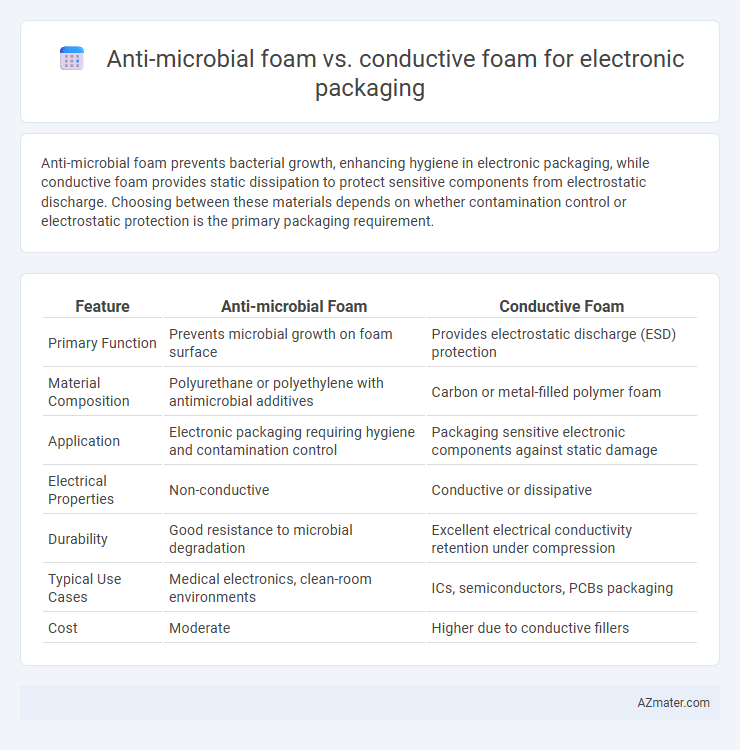Anti-microbial foam prevents bacterial growth, enhancing hygiene in electronic packaging, while conductive foam provides static dissipation to protect sensitive components from electrostatic discharge. Choosing between these materials depends on whether contamination control or electrostatic protection is the primary packaging requirement.
Table of Comparison
| Feature | Anti-microbial Foam | Conductive Foam |
|---|---|---|
| Primary Function | Prevents microbial growth on foam surface | Provides electrostatic discharge (ESD) protection |
| Material Composition | Polyurethane or polyethylene with antimicrobial additives | Carbon or metal-filled polymer foam |
| Application | Electronic packaging requiring hygiene and contamination control | Packaging sensitive electronic components against static damage |
| Electrical Properties | Non-conductive | Conductive or dissipative |
| Durability | Good resistance to microbial degradation | Excellent electrical conductivity retention under compression |
| Typical Use Cases | Medical electronics, clean-room environments | ICs, semiconductors, PCBs packaging |
| Cost | Moderate | Higher due to conductive fillers |
Introduction to Electronic Packaging Foams
Electronic packaging foams play a crucial role in protecting sensitive components from mechanical shock, vibration, and environmental contamination. Anti-microbial foam incorporates biocidal agents to inhibit bacterial growth, ideal for cleanroom or medical device electronics. Conductive foam, infused with carbon or metal particles, facilitates electrostatic discharge (ESD) protection by providing a controlled path for static electricity, ensuring the safety and functionality of electronic assemblies.
What is Anti-microbial Foam?
Anti-microbial foam is a specialized packaging material infused with biocidal agents designed to inhibit the growth of bacteria, fungi, and other microbes on electronic components during storage and transport. This type of foam enhances the protection of sensitive electronic devices by maintaining a sterile environment, reducing the risk of contamination-related damage or corrosion. Unlike conductive foam, which primarily prevents electrostatic discharge, anti-microbial foam focuses on microbial resistance to extend the shelf life and reliability of electronic packaging.
What is Conductive Foam?
Conductive foam is a specialized packaging material embedded with conductive particles that provide electrostatic discharge (ESD) protection for sensitive electronic components during transportation and storage. It effectively dissipates static electricity by grounding any charge buildup, thereby preventing damage to integrated circuits and semiconductors. Unlike anti-microbial foam, which prioritizes microbial inhibition, conductive foam specifically safeguards electronics by maintaining an electrically safe environment.
Key Properties Comparison: Anti-microbial vs Conductive Foam
Anti-microbial foam in electronic packaging offers superior protection against bacterial and fungal growth, enhancing product hygiene and longevity, whereas conductive foam excels at dissipating static electricity and protecting sensitive electronic components from electrostatic discharge (ESD). Anti-microbial foam typically features biocidal additives and moisture resistance, while conductive foam is characterized by its carbon or metal-filled matrix that ensures electrical conductivity and shielding. The choice between these foams depends primarily on whether microbial contamination control or ESD protection is critical for the application.
Protection Against Environmental Threats
Anti-microbial foam offers enhanced protection against bacterial growth and mold in electronic packaging, reducing contamination risks in sterile or humid environments. Conductive foam provides electrostatic discharge (ESD) protection by dissipating static electricity, critical for safeguarding sensitive electronic components from ESD damage. Combining these properties ensures comprehensive defense against both environmental threats and electrostatic hazards in electronic packaging solutions.
Electrostatic Discharge (ESD) Protection Capabilities
Anti-microbial foam provides protection against bacterial growth but offers limited Electrostatic Discharge (ESD) shielding, making it less suitable for sensitive electronic packaging. Conductive foam is specifically engineered to dissipate static electricity efficiently, ensuring optimal ESD protection and safeguarding electronic components during storage and transport. Choosing conductive foam enhances the reliability of electronic devices by preventing damage caused by electrostatic discharge.
Applications in Electronics Industry
Anti-microbial foam is primarily used in electronic packaging to prevent microbial growth, ensuring hygiene and reducing corrosion risk in sensitive medical and wearable devices. Conductive foam serves as an essential material for protecting electronic components from electrostatic discharge (ESD), making it ideal for packaging semiconductors, integrated circuits, and other static-sensitive devices. Both foams enhance device reliability by mitigating contamination and static damage within the electronics industry.
Material Composition and Durability
Anti-microbial foam for electronic packaging incorporates silver-ion or copper-based additives within a polyurethane or polyethylene matrix, providing resistance to microbial growth while maintaining electrical insulation. Conductive foam typically contains carbon black or metal-filled polymers like nickel-coated graphite embedded in polyurethane, ensuring effective static discharge protection. Durability varies as anti-microbial foams offer prolonged protection against biological contaminants but may have lower mechanical strength, whereas conductive foams deliver enhanced compression set resistance and prolonged conductivity under repeated mechanical stress.
Cost Considerations for Each Foam Type
Anti-microbial foam for electronic packaging typically incurs higher costs due to specialized additives that inhibit microbial growth, enhancing product longevity and hygiene. Conductive foam, designed to dissipate electrostatic discharge (ESD), often comes at a premium due to the integration of conductive materials such as carbon or metal fibers. Choosing between these foams depends on balancing the protective benefits against cost, with conductive foam usually being more expensive because of its critical role in safeguarding sensitive electronic components.
Choosing the Right Foam for Electronic Packaging
Selecting the right foam for electronic packaging hinges on understanding specific protective requirements: Anti-microbial foam prevents microbial growth, ensuring hygiene and reducing contamination risks in sensitive environments, while Conductive foam provides electrostatic discharge (ESD) protection essential for safeguarding electronic components from static damage. Anti-microbial foam is ideal for medical or laboratory devices where sterility is critical, whereas Conductive foam suits applications involving static-sensitive electronics, like circuit boards or semiconductor packaging. Evaluating the operational environment, component sensitivity, and regulatory standards helps determine the optimal foam choice for reliable electronic packaging protection.

Infographic: Anti-microbial foam vs Conductive foam for Electronic packaging
 azmater.com
azmater.com